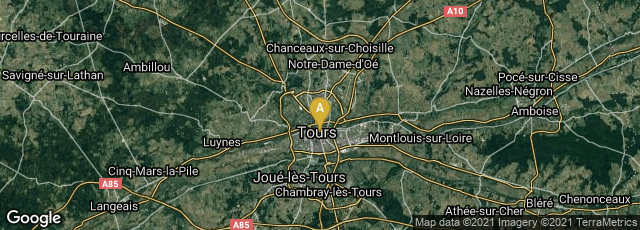Mame operated 30 steam-powered printing machines, all of French manufacture, printing 20,000 books per day, or 6,000,000 volumes per year. We learn much about the work environment in this huge machine room even though the artist provided few specific visual details regarding the machines.
Mame's bookbindery was probably the largest depicted in the 19th century. In this image there may be several hundred people working in the huge facility. No women are visible. Strangely, there appears to be a water fountain in the middle of the room. Dodd's Curiosities of Industry, Printing: Its Modern Varieties (1852) p. 10 suggests, probably with some exaggeration, that Mame may have employed as many as 1000 people in this department.
This warehouse stored an immense number of printed sheets of various awaiting binding after they received orders.
Mame combined all his book production and sale departments in a complex of interconnected buildings as depicted in 1867.


A: Tours, Centre-Val de Loire, France
One of the best produced promotional books about a printing and publishing business issued in the second half of the 19th century was Imprimerie - Librairie - Relieure. Alfred Mame et Fils à Tours. Notice et specimens. This folio work, in its original red blind-stamped and gilt cloth binding, with gilt edges, with pages measuring 395 x 270 mm., was issued at Tours in 1867 by Imprimerie Alfred Mame to advertise and promote its business in connection with the Paris Exposition universelle of 1867. Beautifully designed and printed on excellent paper, the work has only 18 pages of text, interleaved with many full-page illustrations, followed by more than 100 pages of specimens of title pages, text and illustrations, sometimes printed in two colors, and including many fine examples of engraving. The folio format was used in order to include full-size folio specimens. The 1867 book appears to be a revised edition, with specimens, of a similar work that Mame issued in 1862.
My interest in the volume was primarily in its beautiful engraved images of the different elements of large-scale book production in the mid-19th century. Mame used 30 printing machines, as the image of his huge pressroom shows. And, as one might expect, Mame employed a very large number of manual typesetters. The image of Mame's exceptionally large bindery suggests that virtually all of the binding work was still done by hand. The bindery was the main department in which Mame employed women--from 100 to 150 women at a given time--chefly involved in folding printed sheets in preparation for binding.
Mame's business model involved bringing in house all aspects of book production, including typesetting and printing, engraving, binding, and even bookselling. Mame also was part-owner of a paper mill. One of the specialties of the company was publishing religious or devotional books-- a major topic of book consumption in France during the second half of the 19th century.
Mame's firm employed about 1200 people (700 in production and 400-500 in sales) in what appears to be a rather grand facility, though we may assume that the images glorify or beautify what cannot always have been ideal working conditions. Nevertheless, the environment may have been relatively copasetic as, according to the Wikipedia, "Inspired by the social Catholic ideal, Alfred Mame established for his employees a pension fund for those over sixty, wholly maintained by the firm. He opened schools, which caused him to receive one of the ten thousand francs awards reserved for the 'établissements modèles où régnaient au plus haut degré l'harmonie sociale et le bien-être des ouvriers'. In 1874 Mame organized a system by which his working-men shared in the profits of the firm." (Wikipedia article on Alfred Mame, accessed 05-18-2013).
By the 1860s Mame's facility could print 20,000 gatherings of 10 sheets per day. This equated to a production volume of six million volumes per year--a huge volume reflecting the enormous growth of printing and publishing since printing and papermaking were mechanized between 1810 and 1825. When I last revised this entry in December 2021 the company was still in operation.
Bigmore & Wyman II, 16.
MAME Angers-Paris-Tours. Deux siècles du livre. Tours-Paris: Association "Hôtel Mame Centre Culturel," 1989.
Nicole Dinzart, La maison Mame: Histoire d'une imprimerie-librairie au XIXe siècle. Mémoire pour Diplome d'Études Supérieures Spécalisées.